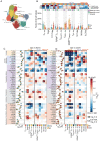This is a preprint.
CD4+ T cells are homeostatic regulators during Mtb reinfection
- PMID: 38187598
- PMCID: PMC10769325
- DOI: 10.1101/2023.12.20.572669
CD4+ T cells are homeostatic regulators during Mtb reinfection
Abstract
Immunological priming - either in the context of prior infection or vaccination - elicits protective responses against subsequent Mycobacterium tuberculosis (Mtb) infection. However, the changes that occur in the lung cellular milieu post-primary Mtb infection and their contributions to protection upon reinfection remain poorly understood. Here, using clinical and microbiological endpoints in a non-human primate reinfection model, we demonstrate that prior Mtb infection elicits a long-lasting protective response against subsequent Mtb exposure and that the depletion of CD4+ T cells prior to Mtb rechallenge significantly abrogates this protection. Leveraging microbiologic, PET-CT, flow cytometric, and single-cell RNA-seq data from primary infection, reinfection, and reinfection-CD4+ T cell depleted granulomas, we identify differential cellular and microbial features of control. The data collectively demonstrate that the presence of CD4+ T cells in the setting of reinfection results in a reduced inflammatory lung milieu characterized by reprogrammed CD8+ T cell activity, reduced neutrophilia, and blunted type-1 immune signaling among myeloid cells, mitigating Mtb disease severity. These results open avenues for developing vaccines and therapeutics that not only target CD4+ and CD8+ T cells, but also modulate innate immune cells to limit Mtb disease.
Conflict of interest statement
DECLARATIONS OF INTERESTS A.K.S. reports compensation for consulting and/or scientific advisory board membership from Honeycomb Biotechnologies, Cellarity, Ochre Bio, Relation Therapeutics, FL86, IntrECate Biotherapeutics, Bio-Rad Laboratories, Senda Biosciences and Dahlia Biosciences unrelated to this work. S.M.F. reports compensation for board of directors membership from Oxford Nanopore unrelated to this work.
Figures







References
-
- Abel L., Fellay J., Haas D.W., Schurr E., Srikrishna G., Urbanowski M., Chaturvedi N., Srinivasan S., Johnson D.H., Bishai W.R., 2018. Genetics of human susceptibility to active and latent tuberculosis: present knowledge and future perspectives. Lancet Infect. Dis. 18, e64–e75. 10.1016/S1473-3099(17)30623-0 - DOI - PMC - PubMed
-
- Ahrends T., Spanjaard A., Pilzecker B., Bąbała N., Bovens A., Xiao Y., Jacobs H., Borst J., 2017. CD4+ T Cell Help Confers a Cytotoxic T Cell Effector Program Including Coinhibitory Receptor Downregulation and Increased Tissue Invasiveness. Immunity 47, 848–861.e5. 10.1016/j.immuni.2017.10.009 - DOI - PubMed
-
- Almanzar N., Antony J., Baghel A.S., Bakerman I., Bansal I., Barres B.A., Beachy P.A., Berdnik D., Bilen B., Brownfield D., Cain C., Chan C.K.F., Chen M.B., Clarke M.F., Conley S.D., Darmanis S., Demers A., Demir K., de Morree A., Divita T., du Bois H., Ebadi H., Espinoza F.H., Fish M., Gan Q., George B.M., Gillich A., Gòmez-Sjöberg R., Green F., Genetiano G., Gu X., Gulati G.S., Hahn O., Haney M.S., Hang Y., Harris L., He M., Hosseinzadeh S., Huang A., Huang K.C., Iram T., Isobe T., Ives F., Jones R.C., Kao K.S., Karkanias J., Karnam G., Keller A., Kershner A.M., Khoury N., Kim S.K., Kiss B.M., Kong W., Krasnow M.A., Kumar M.E., Kuo C.S., Lam J., Lee D.P., Lee S.E., Lehallier B., Leventhal O., Li G., Li Q., Liu L., Lo A., Lu W.-J., Lugo-Fagundo M.F., Manjunath A., May A.P., Maynard A., McGeever A., McKay M., McNerney M.W., Merrill B., Metzger R.J., Mignardi M., Min D., Nabhan A.N., Neff N.F., Ng K.M., Nguyen P.K., Noh J., Nusse R., Pálovics R., Patkar R., Peng W.C., Penland L., Pisco A.O., Pollard K., Puccinelli R., Qi Z., Quake S.R., Rando T.A., Rulifson E.J., Schaum N., Segal J.M., Sikandar S.S., Sinha R., Sit R.V., Sonnenburg J., Staehli D., Szade K., Tan M., Tan W., Tato C., Tellez K., Dulgeroff L.B.T., Travaglini K.J., Tropini C., Tsui M., Waldburger L., Wang B.M., van Weele L.J., Weinberg K., Weissman I.L., Wosczyna M.N., Wu S.M., Wyss-Coray T., Xiang J., Xue S., Yamauchi K.A., Yang A.C., Yerra L.P., Youngyunpipatkul J., Yu B., Zanini F., Zardeneta M.E., Zee A., Zhao C., Zhang F., Zhang H., Zhang M.J., Zhou L., Zou J., The Tabula Muris Consortium, 2020. A single-cell transcriptomic atlas characterizes ageing tissues in the mouse. Nature 583, 590–595. 10.1038/s41586-020-2496-1 - DOI - PMC - PubMed
Publication types
Grants and funding
LinkOut - more resources
Full Text Sources
Other Literature Sources
Research Materials
